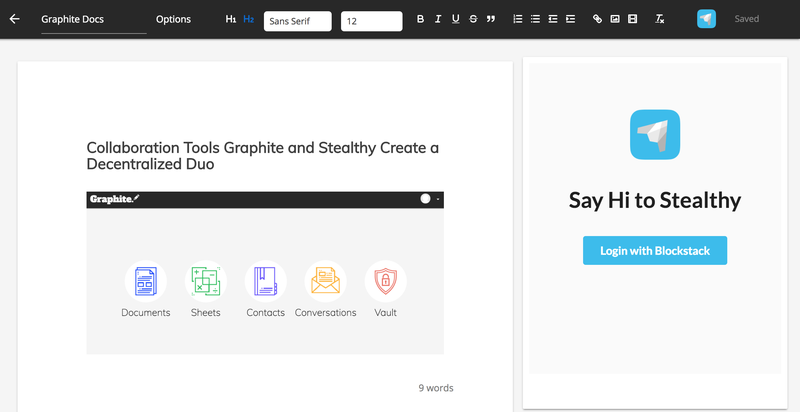Collaboration Tools Graphite and Stealthy Create a Decentralized Duo

At a time when concerns over how big companies like Facebook, LinkedIn and Google are handling our data continue to grow, two blockchain-based apps have joined forces to offer productivity tools that give you full control over your own data.
Graphite Docs, a decentralized alternative to Google G-suite, has integrated with decentralized messaging app Stealthy, the two companies announced on April 12, 2018. What that means is users of Graphite Docs are now able to view documents and chat with friends and coworkers on a single screen.
“The integration brings a Stealthy module into your Graphite documents just like you see with the Google Hangouts module inside a Google Doc,” Graphite Docs creator Justin Hunter told Bitcoin Magazine.
How It Works
Similar to Google G-suite, Graphite Docs is a web app for documents and spreadsheets that includes an email alternative called “conversations.” You can use it to share files, make edits and collaborate. But the main difference, Hunter says, is that while Google has access to all your data, Graphite Docs never sees your data. With Graphite Docs, you still store your data on cloud servers — Dropbox, Amazon or even Google — but your data is encrypted, and your encryption keys stay on your own devices, so you maintain control of your data.
“Let’s say Google wants to look at your documents, all they are going to see is an encrypted blob and they can’t decrypt that — only you can decrypt that with the encryption keys that you have,” said Hunter.
Stealthy, a peer-to-peer communication platform with messaging, screen sharing, video chat and more, offers similar privacy features. That is because both apps are powered by Blockstack, a network for decentralized apps that works on top of the Bitcoin blockchain. Hunter likes to point out that the collaboration between Graphite Docs and Stealthy represents the first integration between two decentralized apps ever.
Blockstack
Apps on the Blockstack platform are accessed through a browser, but the apps themselves run locally on your computer, along with the Blockstack software which stores your ID information that you use to access the Blockstack apps.
“When you create an account on Graphite Docs, Blockstack creates a self-sovereign identity that is written to the Bitcoin blockchain,” said Hunter. Blockstack then uses that ID information to create a set of encryption keys for each app you use on the platform.
Blockstack gives you a choice of storing your encrypted data on your computer or Blockstack’s own servers. For its part, Graphite Docs allows you to choose what cloud services you want to store your encrypted data on; that way, in addition to having your data stored through Blockstack, it is also replicated, protecting it against any single point of failure.
Up Next: Enterprise Tools
The consumer version of Graphite Docs, including Stealthy, is free. Looking to the future, Hunter says he is focused on building a paid enterprise version of Graphite Docs for schools, NGOs, businesses and other institutions, so they, too, can own their own data. Similarly, Stealthy is also building additional features to support widespread adoption.
Hunter is the lone employee of Graphite Docs. So far he says, he has managed everything himself and has not received outside funding for the project. Similarly, Stealthy is being bootstrapped by its founders, Prabhaav Bhardwaj and Alex Carreira.
This article originally appeared on Bitcoin Magazine.


